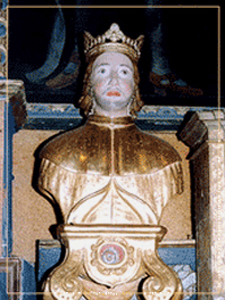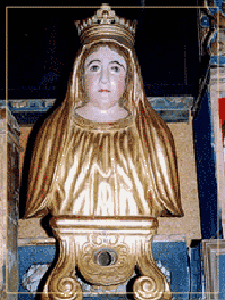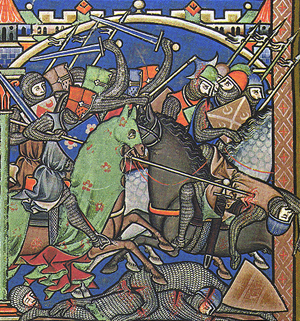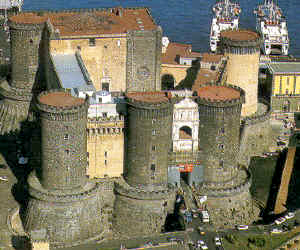 |
The Saint of the Day
St. Elzear – September 27
Prof. Plinio Corrêa de Oliveira
Biographical selection:
Elzear of Sabran (1285-1325) was born in Saint-Jean de Robians in Provence, France. He was son of the Count of Ariano from the Kingdom of Naples, Italy. His mother consecrated him to God as soon as he was born and raised him with good customs. He was well educated in the eternal and human sciences, as well as in the exercise of weapons. He became an outstanding knight and a champion in the tournaments. He married Delphine of Glandèves. By common agreement, they lived a life of continence. Both belonged to the Third Order of St. Francis.

Busts of St. Elzear of Sabran and his wife Dauphine of Glandeves in the Castle of Ansouis, France
 |
When his father died in 1309, he inherited the County of Ariano and went to Italy to assume the government. With John, the brother of the King of Naples, he commanded an army against Emperor Henry VII, who led the anti-papist Ghibelline party in Italy. After two battles, Elzear defeated the German sovereign, who died soon afterward in 1313. As reward for his victories, Count Elzear received many honors and prizes.
King Robert of Naples chose him to be head of the Counsel of the Kingdom of Naples. As a judge he acted with supreme severity against the guilty, be they corrupt nobles or the lawless bandits who infested the whole Kingdom, and often condemned them to death. But he always took great care of the souls of those men, providing them all spiritual assistance possible and asking the priests to remain with them from the moment of condemnation until the hour of death. He was also chosen to be tutor of Prince Charles, heir to the throne.
After four years of separation, Delphine joined him from France and found her husband among the brilliant courtiers wearing magnificent clothes. She feared that during this period of separation Elzear had forgotten his duties of religion and became worldly. He sensed her thoughts, and when the two were alone together, he opened his habit and revealed his hair-shirt underneath. He always remained faithful to the Franciscan spirit.
God granted Count Elzear the grace of an inalterable serenity. His face was always tranquil, communicating peace. Once he revealed to his wife that it was continuous meditation on Our Lord’s Passion that gave him this gift.
In addition to being a skillful warrior and politician, he was also an adept diplomat. He was sent to Paris as a representative of King Robert to ask the hand of the daughter of the Count of Valois for the Prince Heir of Naples. During this mission he became seriously ill and died on September 27, 1325.
He was buried in the Franciscan habit in the church of the Minor Conventuals at Apt. Many miracles were worked through his intercession. He was canonized 44 years later by Pope Urban V. His wife, Countess Delphine, was still alive.
Comments of Prof. Plinio:
We are given a picture of St. Elzear as a saint who was principally a warrior, a winner of battles and tournaments, a governor of his provinces, and a judge.
In that epoch war was preponderantly an ensemble of individual fights, knight against knight, and soldier against soldier. No one could be weak to fight. In today’s wars, a feeble man can be behind a machine gun and do a lot of damage. In that time, men of war had to be courageous, strong, and skillful in martial deeds. This was St. Elzear. He did not abandon the world with platitudes of hatred for war and love for peace. All his life he engaged in war or exercises preparing for it. Doing this, he became a saint. St. Elzear attained sanctity practicing the heroic virtues that shine in the life of a warrior.

Knights of that epoch had to be physically strong and courageous in battle
Scene from the Maciejowski Bible, 13th c. |
Since he was from a very noble family, the Sabran family, he inherited the fief of his father and became Count d’Ariano in Naples. At that time, the Kingdom of Naples was governed by French Princes. So he also became a saint through the wise governance of his fief. Contrary to the images of saints normally put forth by a sentimental piety, which is also a little progressivist, St. Elzear lived the normal life of a noble at court, which at the time implied among other things, wearing magnificent clothes.
As a reward for his military conquests, the King of Naples made St. Elzear head of the Counsel of the Kingdom. To be charged with handing down Justice is a difficult mission. The fair-minded judge often has to rule against the great, powerful, and wealthy in favor of the small and poor. This kind of judge raises the scorn and anger of many important persons. St. Elzear was a judge who acted before God, making no compromises with men. He combated the corrupt nobles, but also the bandits.
You know that in Italy there is an organized drove of bandits – in Sicily and Calabria it is called the Mafia, and in Naples the Camorra. At that time similar groups of bandits were probably in existence and found in St. Elzear an implacable enemy. But as a perfect Catholic, his behavior was entirely balanced: he condemned the guilty to death for the necessity of the common good, but then he took exquisite care of their souls, trying to save them by all possible means. Death for the body, yes; but life for the soul.

The Castel Nuevo in Naples, built by Charles d'Anjou, grandfather of Robert, the King of St. Elzear
|
One would say that a man with such extraordinary qualities to direct a fief and distribute justice, a prince in the court and a lion in the war, would be a pretentious man, quick to anger, stern and arrogant. But he was not that at all. He was most affable and serene with a pacific physiognomy. Here we have a harmonic contrast characteristic of a soul that lives in sanctifying grace.
Another contrast in his life appears in another episode from the selection. St. Elzear held an important position at court; he was a noble in the fullest sense of the word who carried out with dignity his duties as courtier. Therefore, he dressed in magnificent clothes.
When his wife joined him in Naples after four years she was surprised by the magnificence of his clothes and company, and feared that he had become worldly. When they were by themselves, he opened his fine outer clothing a bit and showed her the discipline that he wore under it. That is to say, he remained the same penitent, detached person he had been before. He wore those magnificent garments to properly fulfill his noble duties and uphold the situation he occupied at court. It is another contrast that is the fruit of grace.
The life of St. Elzear is very rich in contrasts and examples for those who do not have a religious vocation, but are called to live in the world as laypeople.
Let us ask him for confidence in the power of grace, and balance to live our vocation with the needed dignity, brilliance and nobility while maintaining a detached spirit. Like him, we should do everything for the glory of God, and not for ourselves.


  | | Prof. Plinio Corrêa de Oliveira | |
The Saint of the Day features highlights from the lives of saints based on comments made by the late Prof. Plinio Corrêa de Oliveira. Following the example of St. John Bosco who used to make similar talks for the boys of his College, each evening it was Prof. Plinio’s custom to make a short commentary on the lives of the next day’s saint in a meeting for youth in order to encourage them in the practice of virtue and love for the Catholic Church. TIA thought that its readers could profit from these valuable commentaries.
The texts of both the biographical data and the comments come from personal notes taken by Atila S. Guimarães from 1964 to 1995. Given the fact that the source is a personal notebook, it is possible that at times the biographic notes transcribed here will not rigorously follow the original text read by Prof. Plinio. The commentaries have also been adapted and translated for TIA’s site.
|
Saint of the Day | Home | Books | CDs | Search | Contact Us | Donate

© 2002- Tradition in Action, Inc. All Rights Reserved
|
 |

|